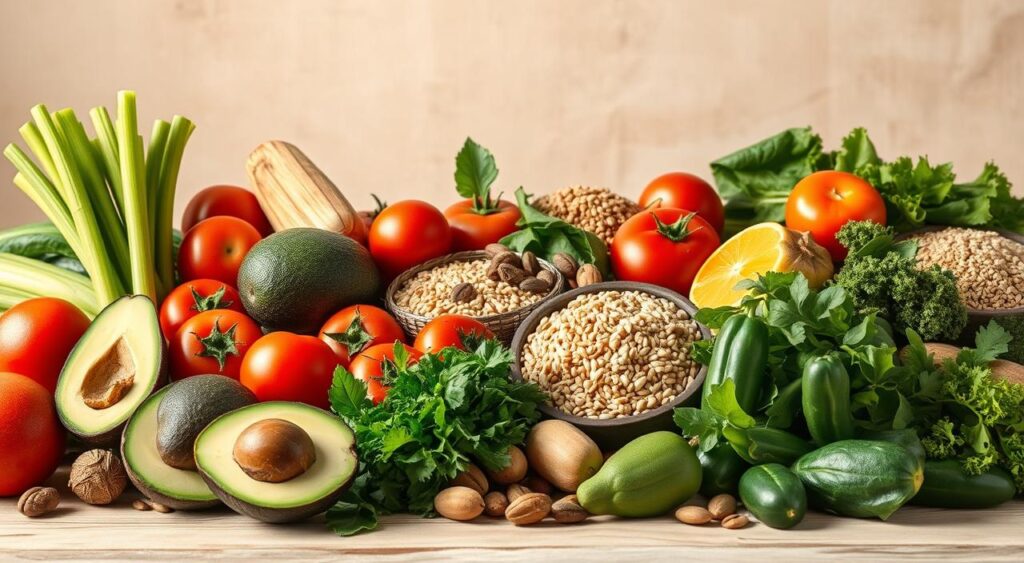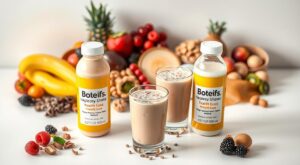Ever thought about how your food choices might affect your energy? Learning about low glycemic index foods could change everything. These foods are digested slowly, which means your body gets glucose gradually. This helps keep your energy stable all day long.
In this article, we’ll look at the best low glycemic foods for managing blood sugar. They can help you avoid those annoying energy crashes. Get ready to find out the top 25 foods that should be in your diet!
Introduction to the Glycemic Index
The glycemic index (GI) helps us understand how carbs affect our blood sugar. It rates foods from 0 to 100, with glucose at 100. Eating low GI foods gives you steady energy without sudden spikes.
Low GI foods take longer to digest, keeping your energy stable. This helps you avoid hunger and energy crashes. It’s great for managing your day.
Adding low GI foods to your diet is good for your health. It helps control blood sugar and supports your health goals. You get important nutrients without too many carbs.
What Are Low Glycemic Index Foods?
Low glycemic index foods help keep your blood sugar stable. Foods with a GI score of 55 or less are low GI. These include whole, unprocessed foods like veggies, fruits, whole grains, legumes, and nuts.
Eating healthy low glycemic foods can help you manage your weight. It also keeps you feeling full for longer. Check out a low glycemic foods list to pick the right foods for your meals.
Choosing low GI foods is good for your blood sugar and overall health. They’re packed with nutrients and fit well into a balanced diet. This makes them a great choice for boosting your nutrition.
| Food Category | Example Foods | GI Score |
|---|---|---|
| Fruits | Cherries, Apples | 20-40 |
| Vegetables | Spinach, Broccoli | 15-30 |
| Whole Grains | Quinoa, Barley | 50-55 |
| Legumes | Lentils, Chickpeas | 30-45 |
| Nuts | Almonds, Walnuts | 0-15 |
Benefits of Low Glycemic Index Foods
Eating low glycemic index foods has many health benefits. They help control blood sugar levels. This means you won’t get those sudden energy drops that make you feel tired and cranky.
These foods also help with weight management. They keep your insulin levels stable. This makes you feel full longer, helping you stay at a healthy weight without constant hunger.
Plus, they lower your risk of getting diabetes. Studies show that eating low glycemic foods improves your body’s insulin use. This is good news for your health in the long run.
Lastly, they might even reduce your risk of heart disease. Foods with a low glycemic index are often full of fiber and nutrients. This is great for your heart and can help lower your cholesterol.
| Benefits | Description |
|---|---|
| Improved Blood Sugar Control | Helps to maintain steady energy levels without sudden spikes. |
| Weight Management | Promotes satiety, reducing cravings for unhealthy snacks. |
| Lower Risk of Diabetes | Enhances insulin sensitivity, decreasing the risk of type 2 diabetes. |
| Reduced Heart Disease Risk | Higher fiber content supports heart health and lowers cholesterol. |
Understanding the Glycemic Index Scale
The glycemic index scale sorts foods by how they affect blood sugar. It groups foods into three categories: low GI (55 or less), medium GI (56-69), and high GI (70 and above). Knowing where a food falls on this scale helps you choose better for stable glucose levels.
Low GI foods slowly release glucose, giving you steady energy and avoiding blood sugar spikes. High GI foods, on the other hand, cause quick rises and drops in blood sugar. This can make you feel tired and hungry soon after eating.
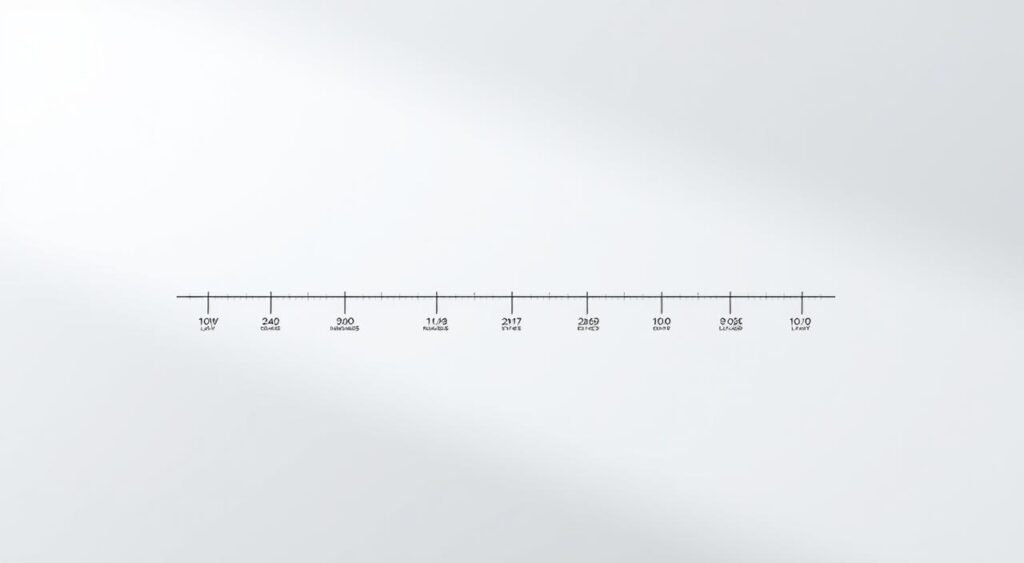
Glycemic load is another key concept. It looks at a food’s total carbs and GI. This gives a clearer picture of how foods affect blood sugar. For instance, a food with a high GI but low glycemic load might not raise blood sugar much because it has few carbs.
Looking at both glycemic index and glycemic load helps you make better diet choices. Eating low GI foods can help keep your blood sugar healthy. This makes it easier to stay energized and focused all day.
| GI Category | Glycemic Index Range | Examples of Foods |
|---|---|---|
| Low GI | 55 or less | Whole grains, legumes, most fruits |
| Medium GI | 56-69 | Brown rice, sweet corn, whole wheat bread |
| High GI | 70 and above | White bread, sugary drinks, candy |
Top Low Glycemic Index Foods for Diabetes Prevention
Adding the best low glycemic foods to your diet is key for preventing diabetes. These foods don’t raise blood sugar much. They’re great for keeping you healthy. Here are some of the healthiest low glycemic foods to add to your meals.
Almonds and Their Benefits
Almonds have a low glycemic index of 15. They’re full of good fats, fiber, and vitamins. These help your heart and help you manage your weight. Almonds are a great snack for those trying to prevent diabetes.
Artichokes: A Nutrient Powerhouse
Artichokes are also a great choice, with a low glycemic index. They’re full of antioxidants and fiber. This helps your digestion and keeps you full, preventing overeating. Think about adding them to your meals for better health.
Avocados: A Creamy, Healthy Choice
Avocados are tasty and low on the glycemic index. They’re full of healthy fats and fiber. This makes you feel full and helps keep your blood sugar stable. Adding avocados to your diet can boost your overall health.
Eggplant: Versatile and Low-GI
Eggplant is versatile and has a low glycemic index. It’s rich in fiber and low in calories. This helps you feel full and is good for diabetes prevention.
| Food | Glycemic Index | Health Benefits |
|---|---|---|
| Almonds | 15 | Heart-healthy fats, weight management |
| Artichokes | 15 | High in fiber, promotes digestive health |
| Avocados | 15 | Healthy fats, aids in satiety |
| Eggplant | 20 | Low-calorie, curbs appetite |
Adding these foods to your diet makes your meals tastier and helps you reach your health goals. Each food has its own benefits and helps prevent diabetes. This makes sure your meals are both healthy and enjoyable.
Low Glycemic Index Foods List: Fruits and Vegetables
Adding low glycemic fruits and vegetables to your diet helps keep blood sugar steady. These foods are full of nutrients and vitamins. Here, we highlight two great options for you.
Cherries: Delicious and Nutritious
Cherries have a low glycemic index of 22. They are full of antioxidants, which are good for your heart. Eating cherries can help reduce inflammation and boost your health.
Enjoy them fresh, frozen, or in smoothies. They taste sweet without raising blood sugar too fast.
Sweet Potatoes vs. Regular Potatoes
Sweet potatoes are better than regular potatoes for those watching their glycemic index. They have a GI of about 44 and are packed with fiber and vitamins like A. This makes them healthier.
Regular potatoes have a higher GI, which can cause blood sugar to spike. Choosing sweet potatoes for your meals is a healthier option.
| Food Item | Glycemic Index (GI) | Nutritional Benefits |
|---|---|---|
| Cherries | 22 | Rich in antioxidants, supports heart health |
| Sweet Potatoes | 44 | High in fiber, rich in vitamin A |
| Regular Potatoes | 78 | Contains potassium but higher GI |

Legumes: The Power of Beans
Legumes are a key group of low glycemic legumes. They are full of important nutrients and health benefits. These healthy beans are great for any meal. They help control blood sugar and offer lots of protein and fiber.
Chickpeas and Their Health Benefits
Chickpeas have a glycemic index of 28. They are a favorite among healthy beans. They are rich in vitamins, minerals, and fiber. This makes chickpeas good for feeling full and heart health.
You can add them to salads or curries. They boost both taste and nutrition.
Lentils: A Fiber-Rich Option
Lentils are another great low glycemic legume. They are high in fiber, which helps with digestion and keeps energy steady. These pulses offer protein without raising blood sugar.
You can use lentils in soups, stews, or as a salad base. They are a flexible ingredient in your kitchen.
Whole Grains That are Low Glycemic
Choosing low glycemic whole grains is key to keeping your energy stable and improving health. These grains are packed with nutrients and fiber. They help you feel full longer and control blood sugar levels well. Here are two healthy whole grains to add to your diet.
Quinoa: The Protein-Packed Grain
Quinoa is a great choice with a glycemic index of 53. It’s rich in protein and has all nine essential amino acids. This makes it a complete protein source. Adding quinoa to your meals helps repair muscles and keeps energy levels up. Try it in salads, bowls, or as a side dish for its nutty taste and health benefits.
Brown Rice: A Healthy Alternative
Brown rice is a top pick for healthy whole grains. It has a glycemic index of about 55, which helps absorb glucose slowly. This keeps blood sugar steady. Brown rice has more fiber, vitamins, and minerals than white rice, which is good for your digestive health. Use brown rice in stir-fries, casseroles, or grain-based salads for a nutritious meal.
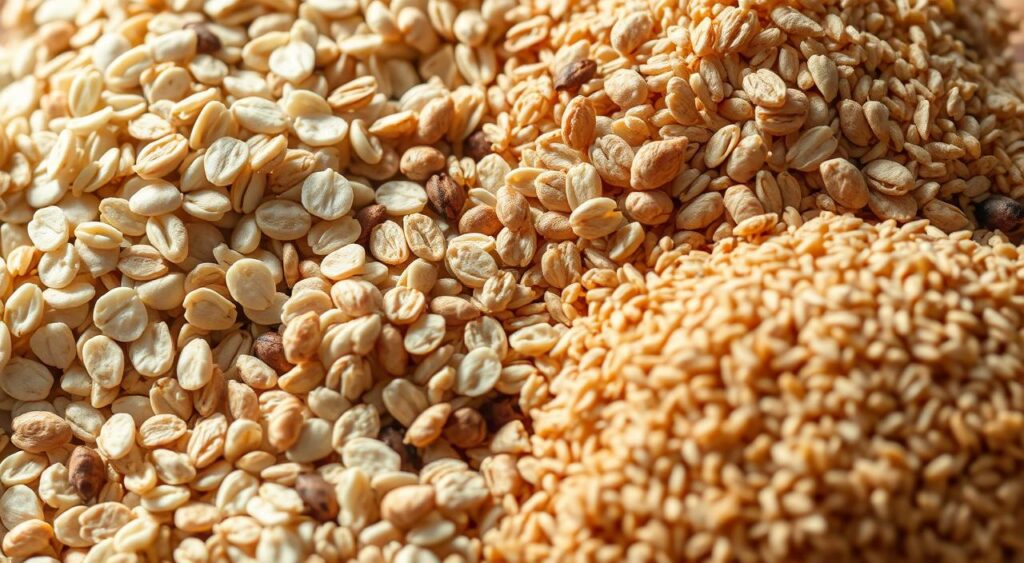
Adding these low glycemic whole grains to your meals can improve them and help manage blood sugar. Try new recipes and find ways to include them in your daily meals for better health.
| Whole Grain | Glycemic Index | Protein Content (per 100g) | Fiber Content (per 100g) |
|---|---|---|---|
| Quinoa | 53 | 4.1g | 2.8g |
| Brown Rice | 55 | 2.6g | 1.8g |
Low Glycemic Snacks to Keep You Full
Craving snacks between meals? Opt for low glycemic snacks to keep your energy up and hunger down. These snacks are not only satisfying but also prevent blood sugar spikes. Discover two great types of snacks that are delicious and good for you.
Nuts: Healthy Fats and Fiber
Nuts are a great mix of healthy fats, protein, and fiber. Almonds, walnuts, and pistachios are perfect for controlling hunger and boosting heart health. They’re a better choice than sugary or refined carb snacks, helping you stay full longer.
Greek Yogurt: A Protein-Rich Snack
Looking for a tasty, protein-rich snack? Greek yogurt is a top pick. It’s high in protein, keeping you full. Choose plain yogurt to avoid added sugars. Add fresh berries or nuts for extra taste without raising the glycemic index.
| Snack | Glycemic Index | Nutritional Benefits |
|---|---|---|
| Nuts (Almonds) | 10 | Rich in vitamin E, magnesium, and fiber |
| Nuts (Walnuts) | 15 | High in omega-3 fatty acids and antioxidants |
| Greek Yogurt | 11 | Good source of protein and probiotics |
| Chia Seed Pudding | 22 | Rich in omega-3s, fiber, and calcium |
| Hummus with Vegetables | 6 | Loaded with fiber, protein, and vitamins |
How to Incorporate Low Glycemic Index Foods into Your Diet
Adding low GI foods to your meals can be fun and rewarding. Start by planning your meals with these foods in mind. Try cooking in batches with quinoa, lentils, and veggies. This saves time and lets you control what you eat.
When eating out, choose low GI options. Look for dishes with whole grains or beans instead of refined carbs. Adding avocado or grilled chicken to a salad makes it more filling and keeps blood sugar steady.
Shopping for groceries is also a chance to make healthy changes. Fill your cart with fresh veggies, legumes, and whole grains. Stay away from processed snacks with high GI. Making smart choices helps you reach your goal of eating low GI foods.
Also, keep healthy snacks like nuts or Greek yogurt on hand. This way, you won’t be tempted by unhealthy snacks when you’re hungry. Making these small changes can greatly improve your eating habits and health.
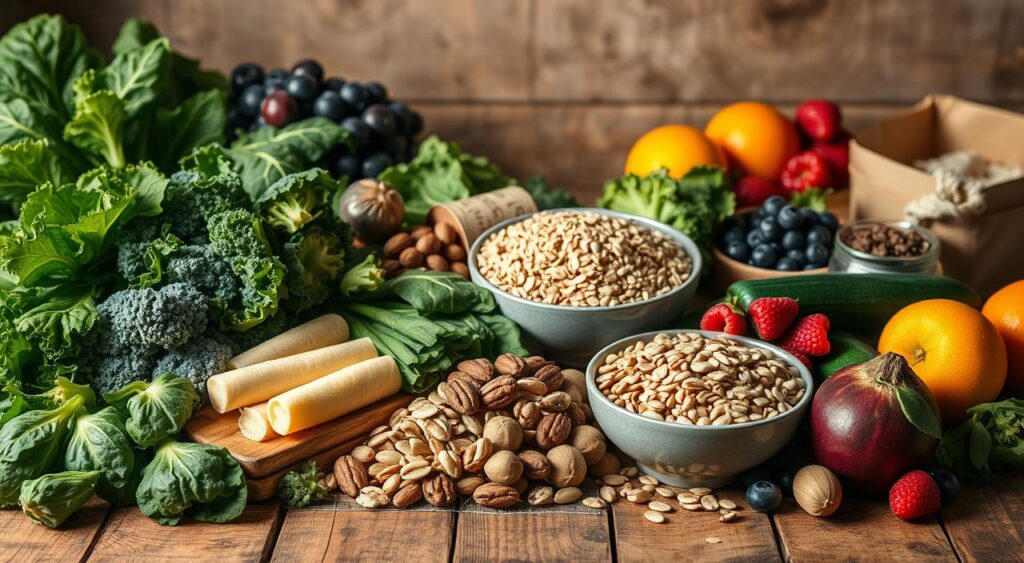
Meal Ideas Featuring Low Glycemic Index Foods
Exploring low glycemic recipes can make your meals tasty and healthy. These foods add flavor and keep your blood sugar steady. Here are some ideas for breakfast, lunch, and dinner.
Breakfast Options to Start Your Day
- Oatmeal topped with chia seeds and fresh berries for a fiber-rich start.
- Greek yogurt mixed with sliced almonds and a sprinkle of cinnamon.
- Scrambled eggs with sautéed spinach, served with whole grain toast.
- Chia pudding made with almond milk and topped with walnuts and strawberries.
Lunch and Dinner Recipes for Glycemic Balance
- Quinoa salad with cherry tomatoes, cucumbers, and a lemon vinaigrette.
- Grilled chicken breast with steamed broccoli and a side of brown rice.
- Baked salmon served with roasted sweet potatoes and sautéed asparagus.
- Lentil soup enriched with carrots, celery, and herbs for a hearty meal.
Common High Glycemic Index Foods to Avoid
Keeping your blood sugar stable is key for good health. Some high glycemic foods to avoid can make your blood sugar spike. Cutting down on these foods can boost your health and improve your diet.
Here are some common foods that can raise your blood sugar:
- White bread and pastries
- Sugary cereals
- Fried foods
- Processed sweets, like candy and cookies
- Soda and other sugary drinks
Eating these foods that raise blood sugar can cause energy crashes and health problems. It’s smart to know and reduce your intake of these foods. This helps your body stay healthy.
Making the Switch to Low Glycemic Foods
Starting a low gi diet can seem daunting, but small steps lead to lasting changes. Begin by adding more whole foods to your diet. Choose whole grains, fruits, veggies, and legumes. Every little change counts.
It’s key to read food labels. Many packaged foods have higher glycemic indexes than you might think. By checking ingredients and GI values, you control your diet better. Also, remember that even low GI foods can raise blood sugar if eaten too much.
Switching to low GI foods has many benefits. For example, choosing quinoa or brown rice over white rice adds fiber and nutrients. This way, you enjoy healthier options without feeling deprived.
Meal planning helps with these changes. Cook meals with low GI foods ahead of time. This way, you have healthy choices when you need them. Remember, every step towards a low gi diet is important.
| Action Step | Description |
|---|---|
| Start Gradually | Introduce low GI foods slowly to your usual meals. |
| Read Food Labels | Check glycemic indices on packaged food for better choices. |
| Understand Portions | Be mindful of serving sizes to avoid overconsumption. |
| Plan Meals Ahead | Prepare low GI meals in advance for convenience. |
Monitoring Your Blood Sugar Levels
Regular blood sugar monitoring is key for those with diabetes or at risk. It helps you adjust your lifestyle and diet. Using glucometers is vital to track your blood glucose levels all day.
It shows how different foods affect you. You can then change your carb intake to keep your blood sugar stable.
Knowing how your body reacts to food is important for glucose management. Some foods raise your blood sugar, while others keep it steady. Keeping a food diary helps you see patterns and changes in your diet.
Writing down what you eat and your blood sugar levels is very helpful. It gives you data to talk about with your doctor.
The following table outlines common monitoring methods and their key features:
| Monitoring Method | Description | Benefits |
|---|---|---|
| Glucometer | Device to measure blood sugar levels. | Quick readings, portable, user-friendly. |
| Continuous Glucose Monitor (CGM) | Provides real-time blood sugar readings. | Alerts for high/low levels, minimal finger pricks. |
| Food Diary | A record of food intake and corresponding glucose levels. | Identifies trends, promotes awareness, supports decision-making. |
Regular monitoring lets you control your health better. By actively managing your blood sugar monitoring, you can improve your glucose management over time.
Conclusion
Adding low glycemic index foods to your diet is key for managing blood sugar and avoiding diabetes. These foods are packed with nutrients and help keep your energy stable. They are essential for eating healthily.
Starting small with your diet can lead to big changes. Every meal is a chance to add more low GI foods. This can improve your health. For more help, check out this meal plan for prediabetes reversal.
Choosing a low GI diet is more than just preventing diabetes. It’s about living a healthier life. By focusing on these foods, you can control your health and feel more energetic and alive.

